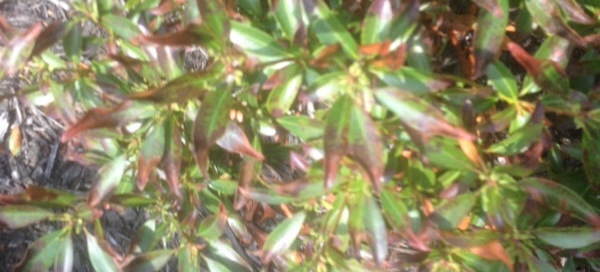Browned Leaves On Mountain Laurel
Leaf-tip browning such as you see can be a result of a couple of problems and without a full-shrub examination it's hard to say which one is causing what you see. But we'll list the possibilities here so that you can do a bit more thinking about what might be the culprit in this case. Note that sometimes what we see in plants has two or three causes and we're seeing the results of more than one issue.
1) Drying or too shallow watering. When plants dry out between watering their leaf tips can brown like this. Be sure that this plant is being watered deeply every four to seven days - do NOT hand water as this is never deep enough. Use a sprinkler or soaker hose, or make sure irrigation systems are going on for more than 45 minutes to deeply soak the ground. Buy a rain gauge to accurately measure rainfall - most established plants are fine if they get one inch of water a week as measured in a gauge, not a tuna can etc. Try to deliver that much if Mother Nature doesn't manage it.
(Note: an inch of mulch or compost around a plant from just beyond the stem to a foot outside the dripline can keep the soil more evenly moist.)
2) Leaf fungus. Although this photo is a bit out of focus so it's hard to see for sure, we can see that there are some spots as well as the browning of the tips. This is usually a fungal issue and is often made worse by splashing the leaves with water. Be sure that this plant isn't getting hit with frequent water from hoses, lawn irrigation etc. If you suspect a fungal problem you can go to your garden center and ask for a fungicide labeled for leaf-spot on mountain laurel.
3. Fertilizer burn? If this plant was fertilized with a synthetic fertilizer shortly before you started to see symptoms, or if a nearby lawn or other plant was fertilized, this might be part of the problem. Too strong fertilizer causes edges and ends of leaves to brown. Always use fertilizer at rates recommended and never apply it to a thirsty plant.
4. Sunburn. Is this plant suddenly in more sun then it was before? Mountain laurel like to grow in places where they get some sunlight but are shaded from hot noon-day and afternoon sun. If this plant is getting hot sun all day or at the hottest part of the day, this could be part of the problem.









